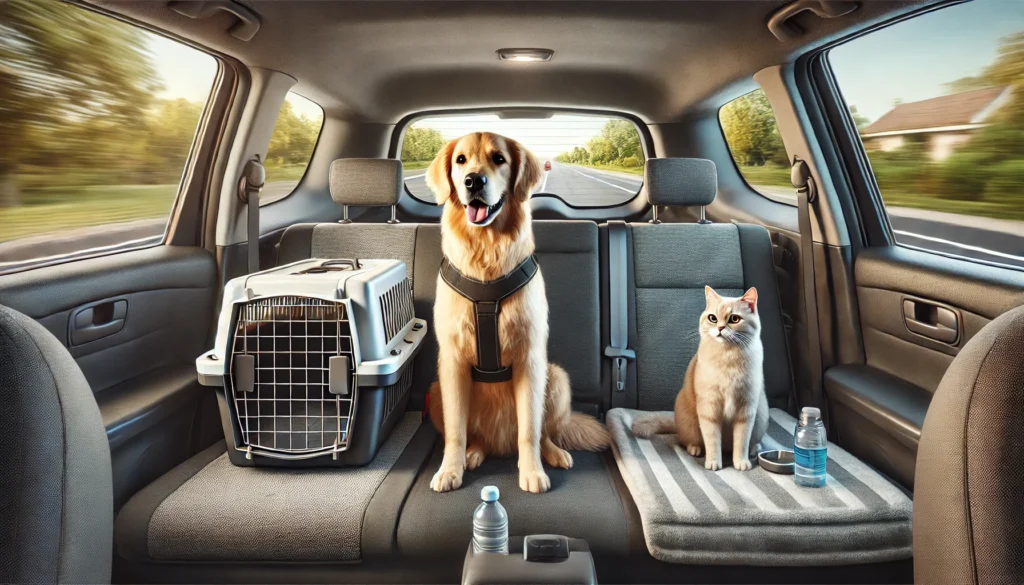Whether you’re heading to the vet, visiting family, or going on a road trip, car travel with pets is part of everyday life for many pet parents. But keeping your furry companion safe and comfortable on the road requires a bit more planning than just letting them hop in and go.
In this guide, you’ll find practical tips to make car travel safer and less stressful for both you and your pet.
Why Car Safety for Pets Matters
Unrestrained pets can be a serious distraction while driving — and in the event of an accident, they’re at risk of injury or even becoming projectiles. A loose pet may also try to jump out of an open window or run off after a sudden stop.
Protecting your pet in the car means:
- Preventing injuries
- Reducing anxiety
- Minimizing distractions
- Keeping everyone in the vehicle safe
With the right setup, car rides can be enjoyable and safe for all passengers.
Choose the Right Restraint System
Just like people wear seatbelts, pets need to be secured in the car. The best method depends on your pet’s size, personality, and the length of the trip.
Options include:
Pet seat belts or harnesses
Designed to clip into your car’s seatbelt system, these keep dogs secure while giving them a bit of room to move.
Crash-tested carriers
For small dogs or cats, sturdy travel carriers offer safety and comfort. Look for ones that can be strapped in with a seatbelt.
Pet booster seats
Ideal for small dogs, these raise your pet up so they can see out the window while staying secured.
Travel crates
Great for medium to large dogs on longer trips. Crates should be well-ventilated and large enough for your dog to stand, turn, and lie down.
Never allow your pet to sit in the front seat or on your lap while driving. Airbags and sudden stops can cause serious harm.
Prepare Before the Trip
A smooth journey starts before you even leave the driveway.
Things to do before traveling:
- Let your pet relieve themselves
- Avoid feeding a large meal right before departure (helps prevent motion sickness)
- Pack a travel bag with essentials like water, food, leash, poop bags, toys, and blankets
- Make sure ID tags and microchips are up to date
If your pet gets nervous in the car, practice short rides to help them adjust gradually.
Keep the Car Comfortable
Creating a calm and comfortable space can help reduce anxiety and motion sickness.
Try this:
- Keep the temperature cool and well-ventilated
- Use a sunshade for hot days
- Play soothing music or white noise
- Bring familiar items (blanket or toy) that smell like home
Avoid letting dogs hang their heads out of the window — it might look fun, but it can lead to injury from debris or sudden stops.
Plan for Breaks on Long Trips
Just like people, pets need to stretch, hydrate, and use the bathroom on longer drives.
Plan to stop every 2–3 hours and:
- Offer water
- Let dogs walk on a leash
- Clean up waste responsibly
- Check for signs of stress or overheating
Never leave your pet alone in the car, even for a few minutes — especially in hot or cold weather. Temperatures inside a vehicle can rise or drop rapidly, posing a serious risk.
Be Ready for Emergencies
Always travel with your pet’s medical info, including vaccination records, a recent photo, and your vet’s contact details.
Other helpful items:
- First-aid kit for pets
- Travel water bowl
- Cleaning wipes or paper towels
- Extra leash or collar
If your pet takes medication, pack extra doses in case of delays or changes in plans.
Special Tips for Cats
Cats often dislike car rides more than dogs. To make it easier:
- Use a secure, well-ventilated carrier
- Place a towel over the carrier to reduce visual stress
- Use calming sprays (like Feliway) inside the carrier
- Start with short trips and increase gradually
Avoid opening the carrier in the car unless you’re parked with all doors and windows closed.
Considerations for Puppies and Senior Pets
Young and older pets may need special care while traveling.
Puppies:
- May need more frequent bathroom breaks
- Can get carsick — travel on an empty stomach if needed
- Should always be secured for safety
Senior pets:
- Might need extra padding or orthopedic support
- May have mobility issues — use ramps or gentle lifting
- Could be more sensitive to temperature changes
Adjust your setup based on your pet’s age and health needs.
Final Thought: Safe Travel Makes Better Adventures
Car trips with your pet don’t have to be stressful. With a little preparation, the right gear, and a focus on comfort and safety, you can make every ride a positive experience.
Whether you’re going across town or across the country, traveling together becomes much more enjoyable when your pet is secure, calm, and happy to be along for the ride.






